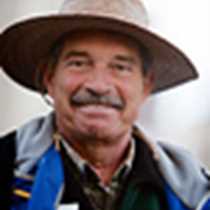Isla Coronados, Baja California Sur
Our day began in the vicinity of Isla Coronados, in the incredible Gulf of California. Soon after breakfast we had landed on a small white-sand beach, made up of fossils, mostly mollusks. These sea-shells had been deposited there during the end of the Pliocene and probably during the beginning of the Pleistocene, and were included in loose limestone.
After organizing the different groups, we began our long or short walks across the small island, through a desert landscape formed by leafless Adam’s trees, the giant cactus called cardones and sweet pitahayas. There was quite a bit of smaller vegetation, formed mostly by limberbushes, wild cotton and chollas. The path we took led us to the other side of the island, to a lovely beach with a small thatched-roof shelter. Shelter from the sun, that is! The different naturalists illustrated guests with their knowledge, and nature did the rest.
The island is one huge volcano, with a cone, formed of solid orange-brown basalt rocks, which even ring if they are thrown against each other. Different parts of the slopes of the old cone are covered with these small boulders and rocks. Here some of us saw lizards of different species, and even a big chuckwalla, one of the so many denizens of the island.
Our young kids played at the beach for hours, with the colored sand, and some of us snorkeled from the beach. Many urchins were seen, as well as other invertebrates. Some others of us took in the sun!
By midday we were all back on the ship, and had a delicious lunch. Immediately after, we sailed away north, to cover the so many miles necessary to reach Santa Rosalia, that old copper city of Baja California, where copper was smelted for a long time. Tomorrow we go by highway and bus, to see the gray whales on the other side of the peninsula.
Our day began in the vicinity of Isla Coronados, in the incredible Gulf of California. Soon after breakfast we had landed on a small white-sand beach, made up of fossils, mostly mollusks. These sea-shells had been deposited there during the end of the Pliocene and probably during the beginning of the Pleistocene, and were included in loose limestone.
After organizing the different groups, we began our long or short walks across the small island, through a desert landscape formed by leafless Adam’s trees, the giant cactus called cardones and sweet pitahayas. There was quite a bit of smaller vegetation, formed mostly by limberbushes, wild cotton and chollas. The path we took led us to the other side of the island, to a lovely beach with a small thatched-roof shelter. Shelter from the sun, that is! The different naturalists illustrated guests with their knowledge, and nature did the rest.
The island is one huge volcano, with a cone, formed of solid orange-brown basalt rocks, which even ring if they are thrown against each other. Different parts of the slopes of the old cone are covered with these small boulders and rocks. Here some of us saw lizards of different species, and even a big chuckwalla, one of the so many denizens of the island.
Our young kids played at the beach for hours, with the colored sand, and some of us snorkeled from the beach. Many urchins were seen, as well as other invertebrates. Some others of us took in the sun!
By midday we were all back on the ship, and had a delicious lunch. Immediately after, we sailed away north, to cover the so many miles necessary to reach Santa Rosalia, that old copper city of Baja California, where copper was smelted for a long time. Tomorrow we go by highway and bus, to see the gray whales on the other side of the peninsula.



